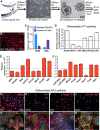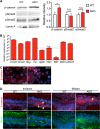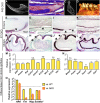Cessation of epithelial Bmp signaling switches the differentiation of crown epithelia to the root lineage in a β-catenin-dependent manner
- PMID: 24081330
- PMCID: PMC3838012
- DOI: 10.1128/MCB.00456-13
Cessation of epithelial Bmp signaling switches the differentiation of crown epithelia to the root lineage in a β-catenin-dependent manner
Abstract
The differentiation of dental epithelia into enamel-producing ameloblasts or the root epithelial lineage compartmentalizes teeth into crowns and roots. Bmp signaling has been linked to enamel formation, but its role in root epithelial lineage differentiation is unclear. Here we show that cessation of epithelial Bmp signaling by Bmpr1a depletion during the differentiation stage switched differentiation of crown epithelia into the root lineage and led to formation of ectopic cementum-like structures. This phenotype is related to the upregulation of Wnt/β-catenin signaling and epithelial-mesenchymal transition (EMT). Although epithelial β-catenin depletion during the differentiation stage also led to variable enamel defect and precocious/ectopic formation of fragmented root epithelia in some teeth, it did not cause ectopic cementogenesis and inhibited EMT in cultured dental epithelia. Concomitant epithelial β-catenin depletion rescued EMT and ectopic cementogenesis caused by Bmpr1a depletion. These data suggested that Bmp and Wnt/β-catenin pathways interact antagonistically in dental epithelia to regulate the root lineage differentiation and EMT. These findings will aid in the design of new strategies to promote functional differentiation in the regeneration and tissue engineering of teeth and will provide new insights into the dynamic interactions between the Bmp and Wnt/β-catenin pathways during cell fate decisions.
Figures








Similar articles
-
Disruption of Wnt/β-catenin signaling in odontoblasts and cementoblasts arrests tooth root development in postnatal mouse teeth.Int J Biol Sci. 2013;9(3):228-36. doi: 10.7150/ijbs.5476. Epub 2013 Feb 19. Int J Biol Sci. 2013. PMID: 23494738 Free PMC article.
-
Constitutive stabilization of ß-catenin in the dental mesenchyme leads to excessive dentin and cementum formation.Biochem Biophys Res Commun. 2011 Sep 9;412(4):549-55. doi: 10.1016/j.bbrc.2011.07.116. Epub 2011 Aug 10. Biochem Biophys Res Commun. 2011. PMID: 21854758
-
Loss of β-catenin causes cementum hypoplasia by hampering cementogenic differentiation of Axin2-expressing cells.J Periodontal Res. 2023 Apr;58(2):414-421. doi: 10.1111/jre.13101. Epub 2023 Jan 24. J Periodontal Res. 2023. PMID: 36691857
-
Origins of cementum.Oral Dis. 1996 Mar;2(1):63-9. doi: 10.1111/j.1601-0825.1996.tb00205.x. Oral Dis. 1996. PMID: 8957939 Review.
-
Enamel knots as signaling centers linking tooth morphogenesis and odontoblast differentiation.Adv Dent Res. 2001 Aug;15:14-8. doi: 10.1177/08959374010150010401. Adv Dent Res. 2001. PMID: 12640732 Review.
Cited by
-
BMP signaling in the development and regeneration of tooth roots: from mechanisms to applications.Front Cell Dev Biol. 2023 Sep 15;11:1272201. doi: 10.3389/fcell.2023.1272201. eCollection 2023. Front Cell Dev Biol. 2023. PMID: 37779895 Free PMC article. Review.
-
Bone Morphogenetic Protein (BMP) signaling in development and human diseases.Genes Dis. 2014 Sep;1(1):87-105. doi: 10.1016/j.gendis.2014.07.005. Genes Dis. 2014. PMID: 25401122 Free PMC article.
-
Sox21 Regulates Anapc10 Expression and Determines the Fate of Ectodermal Organ.iScience. 2020 Jul 24;23(7):101329. doi: 10.1016/j.isci.2020.101329. Epub 2020 Jun 30. iScience. 2020. PMID: 32674056 Free PMC article.
-
Cellular and molecular mechanisms of tooth root development.Development. 2017 Feb 1;144(3):374-384. doi: 10.1242/dev.137216. Development. 2017. PMID: 28143844 Free PMC article. Review.
-
Cell dynamics in Hertwig's epithelial root sheath are regulated by β-catenin activity during tooth root development.J Cell Physiol. 2021 Jul;236(7):5387-5398. doi: 10.1002/jcp.30243. Epub 2020 Dec 30. J Cell Physiol. 2021. PMID: 33377198 Free PMC article.
References
-
- Diekwisch TG. 2001. The developmental biology of cementum. Int. J. Dev. Biol. 45:695–706 - PubMed
-
- Zeichner-David M. 2006. Regeneration of periodontal tissues: cementogenesis revisited. Periodontol. 2000 41:196–217 - PubMed
-
- Tummers M, Thesleff I. 2003. Root or crown: a developmental choice orchestrated by the differential regulation of the epithelial stem cell niche in the tooth of two rodent species. Development 130:1049–1057 - PubMed
Publication types
MeSH terms
Substances
Grants and funding
LinkOut - more resources
Full Text Sources
Other Literature Sources
Molecular Biology Databases
